News
Trump Gets Unhinged, Even for Him, Over Kamala Harris ‘60 Minutes’ Interview
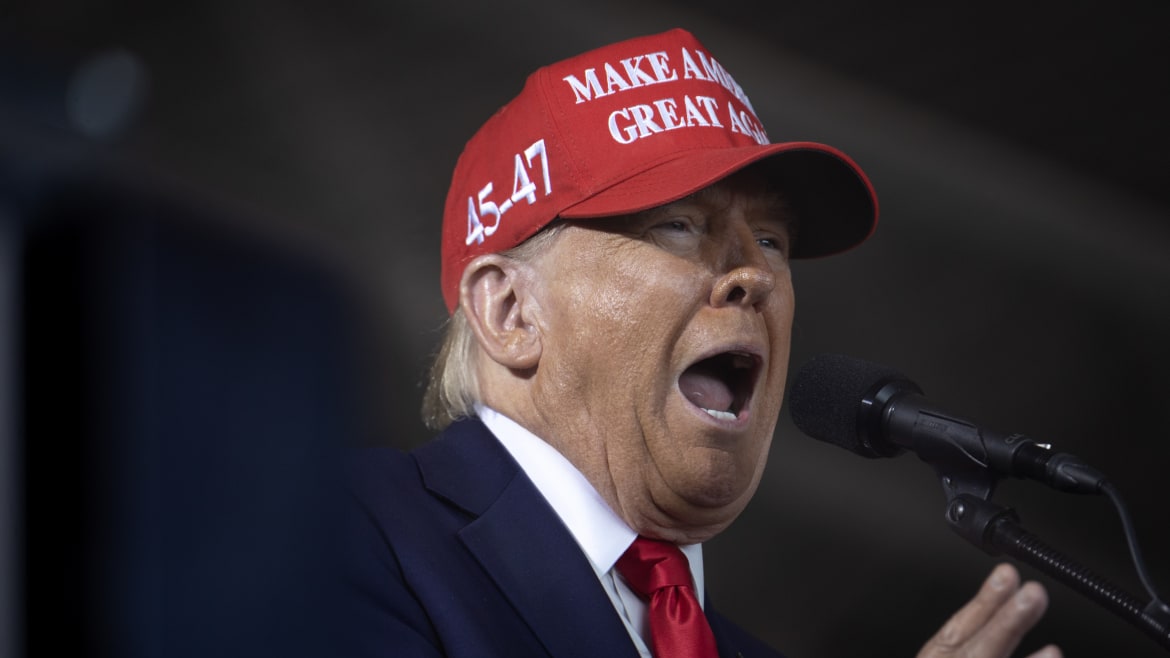
Donald Trump—who agreed to an interview with the CBS newsmagazine show 60 Minutes before backing out—has gone on the warpath at Kamala Harris for her performance on the show.
“The Interview on 60 Minutes with Comrade Kamala Harris is considered by many of those who reviewed it, the WORST Interview they have ever seen,” he wrote, in a Tuesday morning post on Truth Social. “She literally had no idea what she was talking about, and it was an embarrassment to our Country that a Major Party Candidate would be so completely inept.”
Donald J. Trump/Truth Social
Harris, who has been criticized for keeping a light media schedule mostly contained to friendly interviewers, took a grilling on the program about the Biden administration’s border policies, her economic platform, and allegations that she has changed her positions on issues.
Harris Responds to Trump Canceling on ‘60 Minutes’ With Some Advice
Trump seemingly wants no part of that level of scrutiny. The Republican nominee for president accepted an invitation to a similar sitdown interview on the storied program, but his campaign later “decided not to participate,” a CBS spokesperson told CNN.
Trump spokesperson Steven Cheung claimed it was “fake news” to suggest the campaign ever agreed to the appearance, claiming “60 Minutes begged for an interview.” That was untrue, and 60 Minutes revealed communications from Cheung on Monday that showed the Trump camp had agreed to the sitdown.
‘60 Minutes’ Brings the Receipts on Trump’s Interview About-Face
The Trump team was reportedly worried about 60 Minutes fact-checking the interview, suggesting they were worried the interview might draw attention to Trump’s propensity for telling falsehoods in his freewheeling, extemporaneous ramblings.
Trump has also declined an invitation to a third presidential debate, which CNN proposed for Oct. 23. Harris agreed but Trump—viewed as the loser of their verbal bout last month—claimed it was “too late.”
During her 60 Minutes sitdown, Harris advised voters—given Trump was unwilling to give an interview—to watch his rallies instead, noting they would be treated to talk “about himself and all of his personal grievances.”
Get the Daily Beast’s biggest scoops and scandals delivered right to your inbox. Sign up now.
Stay informed and gain unlimited access to the Daily Beast’s unmatched reporting. Subscribe now.
Money
Customers are furious with popular supermarket beauty brand after it SHRINKS bottles – but kept the price the same

HERBAL Essences customers are in a lather after the haircare firm shrunk its conditioners by almost a THIRD.
Its Dazzling Shine, Hello Hydration, Daily Detox and Ignite My Colour hair moisturisers have gone from 400ml to 275ml in recent months, but remain at around £2.
The product is now sold in tubes rather than bottles after the 31% reduction, leaving customers confused and angry about the change.
One, Brian Brennan, fumed on the review site Trustpilot this week: “My wife has always used the shampoo and conditioner, the prices were very good.
“The shampoo and conditioner were in 400ml bottles. Now they put the conditioner in a 275ml tube container and charge the same price for 125ml less.”
Another added on X: “Why are you no longer selling 400ml bottles of conditioner? Now I can only find 275ml tubes, which means I’ll need to replace them more often – and they’re not that much cheaper!”
A third added: “Just been comparing the old and new Herbal Essences conditioner bottles, and the old one has 400ml, almost half a litre, whereas the new squeezy bottle only has 275ml.
“That’s more than a quarter of your conditioner being stolen from right under your nose!”
Its equivalent shampoo range continues to be sold in 400ml bottles.
Shrinkflation is when products shrink in size but remain at the same price, meaning shoppers pay the same for less.
It’s a tactic often used by companies to avoid hiking prices, as a change if size is less noticeable.
Susannah Streeter, of investment firm Hargreaves Lansdown, said Herbal Essences’ owner Procter and Gamble (P&G) had been increasing prices month on month, which has put off price-conscious shoppers.
She added: “Attempts to limit the effect of price hikes through promotions and discounts have not been enough to win back loyalty.
“P&G has also been affected by weaker spending in China, even for essential items and it’s also been hit by boycotts of Western brands in the Middle East.
“So, the company is looking at other ways to keep costs lower and keep its profits ticking up.
“It appears shrinking sizes on some products, rather than hiking prices, is part of the strategy.”
Procter and Gamble did not comment.
Yesterday The Sun revealed how Cadbury’s family treat bags of chocolates have shrunk down in size.
New packs appearing in recent months have seen the Crunchie axed from the selection, as well as the size reduced from 216g to 207g.
It is the latest chocolatey snack made by the manufacturer to shrink in size.
Cadbury‘s Brunch bar multipacks have also reportedly been reduced in size by a major 12.5%.
Traditionally shoppers were able to bag up a pack of five bars which in total weighed over 160g – or 32g per lunchtime treat.
But now the entire box weighs a whole 20g less with the bars now sitting at 28g each, an investigation by The Grocer has revealed.
The size reduction applies to all the flavours including their raisin, peanut, choc chip and Bournville choc chip choices.
Elsewhere, shoppers have been feeling the crunch after it was revealed that two of Kellog’s four different cereal pack sizes have gone down in weight by 50g.
A box of 720g Kellogg’s Corn Flakes boxes is now 670g and 500g boxes are down to 450g.
But the smaller 670g boxes are being sold at £3.20 in Tesco – the same price as for the larger box when it was sold in May.
Meanwhile, its 450g boxes are £2.19, while the previous 500g boxes were only pennies more at £2.25.
A Kellogg’s spokesman previously told The Sun: “Kellogg’s Corn Flakes are available in four different box sizes to suit different shopper preferences and needs.
“As the cost of ingredients and production processes increase, it costs us more to make our products than it used to.
“This can impact the recommended retail price. It’s the grocer’s absolute discretion and decision what price to charge shoppers.”
Jars of Dolmio sauce reduced in size but remain the same price

THE latest example of shrinkflation sweeping across the UK has seen family favourite pasta sauce brand Dolmio adjust their packaging.
Their 750g jars are now 675g while 500g jars have been trimmed to 450g.
But despite the ten per cent decrease, the price has stayed put at £3 and £2.50 in supermarkets.
It has left customers unhappy at maker Mars, which advertises it on TV with the slogan, “When’sa your Dolmio day?”.
One fan told The Sun: “It’s a family jar but now it’s smaller, so I’ve had to reduce the portions on every plate at the table.
“It’s really disappointing that companies try to hide this from their customers by making sneaky packaging changes instead of just being honest.
“In two months the price will go up again and it’s even worse of a deal.”
A Mars spokeswoman confirmed the changes, telling The Sun: “Like everyone, we’ve experienced significant cost increases across our raw materials and operations, something that we are continuing to see.
“We have been absorbing these rising costs for some time, but the growing pressures we are facing means we needed to take further action.
“While it has been a difficult decision to decrease the weight of our jars, our priority is continuing to provide our great products, without compromising on quality or taste.”
Travel
I was slapped with £75 Ryanair charge because i’m a granny while younger & hotter passengers were let off fee-free
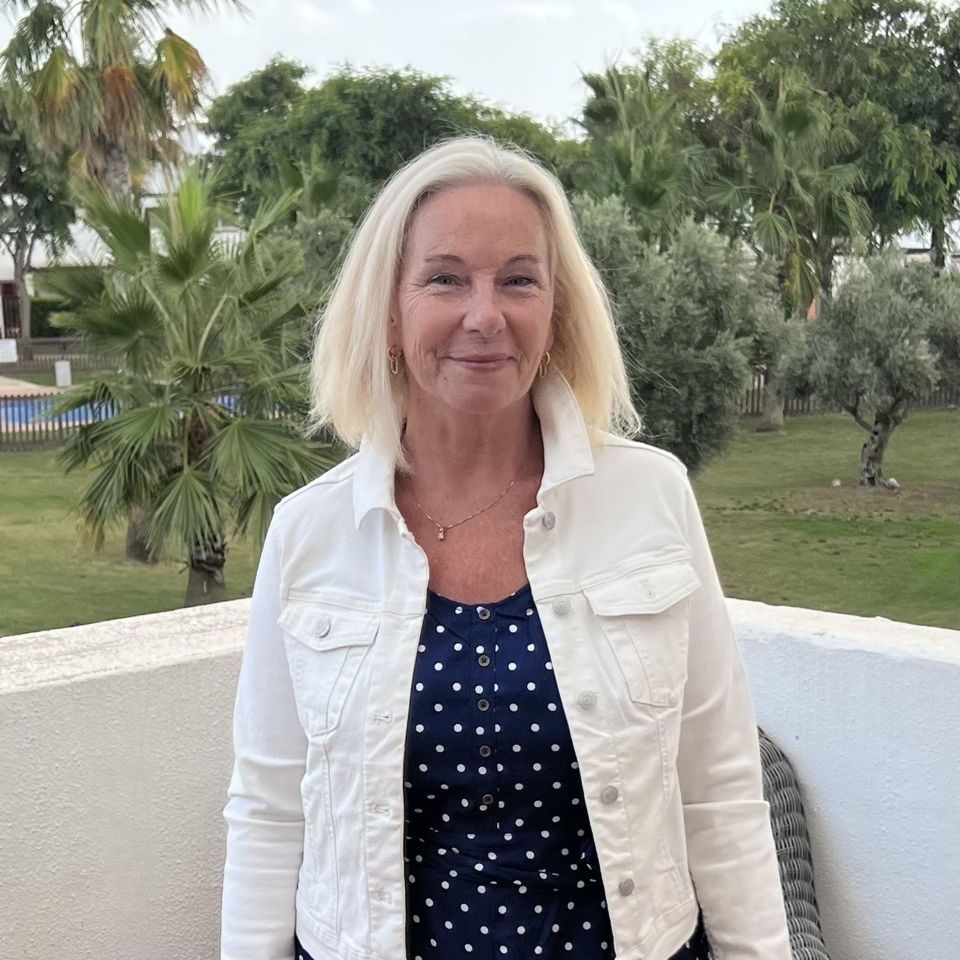
A GRANDMA has been left fuming after she was charged £75 for her oversized suitcase but ‘younger and good looking’ passengers were let off.
Maxine Haughian, 63, was stopped in the queue for her flight to Alicante by Ryanair staff at Leeds Bradford Airport.
The mum-of-two claims her luggage fit inside the guidance rack but “stuck out very slightly” by 2cm on one side.
She was told that her suitcase was too big and she’d need to pay to place the luggage into the hold.
However, Maxine, a retired prison governor, noticed other passengers in the queue being let off for oversized bags.
She described one woman as “young and gorgeous” and even took a sneaky snap of her being let off.
Taking to Facebook, Maxine said she was “disgusted” with Ryanair.
“I’ve just been held up for 20 minutes because they said my cabin bag was too big and I must pay an EXTRA £75 for it to go in hold,” she wrote.
“It’s funny (not funny) how other bags that are exactly the same were allowed through without comment.
“It’s a good job I took the photo of this (gorgeous) girl pushing her case into the box and being allowed through.
“I’m obviously not young or good looking enough!” she fumed.
Maxine, who was travelling with her husband Jim, continued: “Eventually (using photographic evidence) I was allowed through. I’m stressed to high-hell and hope I can calm down and get into holiday mode before we land.”
Despite being pleased that she was let off, Maxine told Oxford Mail: “It was almost like letting me go justified what I was saying. I think it’s definitely a money-making exercise.
“I’m a bit older, perhaps he thought I would be compliant. A lot of people just paid the money.”
She added: “Several people had suitcases that looked exactly the same as mine and they were putting them in the rack and it was sticking out a bit, but they were allowed to go through. It was the inconsistency of it all.
The Sun has contacted Ryanair for comment.
News
Tracking the conflict with Hezbollah and Iran

 BBC
BBCIsrael has invaded southern Lebanon in a dramatic escalation of its conflict with Hezbollah.
The Israeli ground operation began on 30 September, days after an air strike killed Hassan Nasrallah, the leader of the Iran-backed armed group.
Hezbollah has fired rockets into northern Israel as Lebanon has endured three weeks of aerial bombardment that Lebanese authorities say has killed more than 1,000 people and forced up to a million to flee their homes.
Israel has a decades-long history of conflict with Hezbollah but the war in Gaza has sparked a year of deadly cross-border fighting between them.
We will be continually updating maps in this page to help explain the conflict.
Map: Where is Lebanon?
Lebanon is a small country with a population of about 5.5 million people, which borders Syria to the north and east, Israel to the south, and the Mediterranean Sea to the west. It is about 170km (105 miles) away from Cyprus.
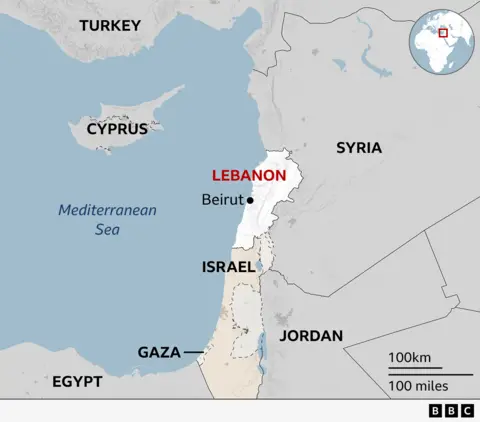
Where is the Israeli advance?
Israeli troops and tanks that had gathered close to the border crossed into Lebanon on 1 October.
The Israel Defense Forces (IDF) has said it is carrying out “limited, localised, and targeted ground raids” in southern Lebanon to dismantle what it calls Hezbollah’s “terrorist infrastructure”.
 Reuters
ReutersIsraeli troops are fighting directly with Hezbollah fighters on the ground.
Several Israeli soldiers have been killed in mortar attacks and ambushes by Hezbollah during operations in southern Lebanon aimed at “eliminating terrorists”, according to the IDF.
Hezbollah said its fighters had clashed with Israeli forces in Adaisseh, Kafr Kila, Maroun al-Ras and Yaroun – all Lebanese villages close to the border with Israel.
A ground operation in southern Lebanon comes with many risks for Israeli forces. Unlike the flat coastal plains of Gaza, southern Lebanon has rolling hills and some mountainous terrain that makes it difficult for tanks to move easily without fear of being ambushed.
Hezbollah is also thought to have a network of tunnels in the region, with the group having been preparing for another full-scale conflict with Israel since the 34-day war in 2006.
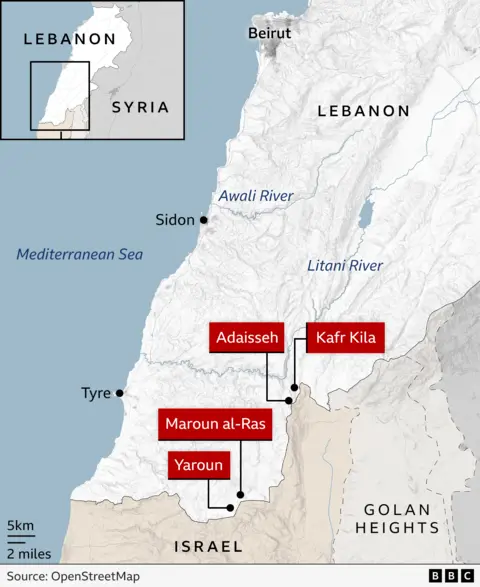
As part of its invasion of southern Lebanon, the IDF has ordered people living in some villages to evacuate, telling those remaining to leave their homes and “immediately head to the north of the Awali River” – which meets the coast about 50km (30 miles) from the border with Israel.
At first the evacuation orders were concentrated in the south east of Lebanon, but in recent days more have been been issued for villages in the south west, perhaps indicating that Israeli operations are about to extend to that part of the border.
Lebanese civilians have also been warned by the IDF not to use vehicles to travel south across the Litani River, located about 30km (20 miles) north of the border.
About a million people lived in southern Lebanon before the conflict escalated almost a year ago.
Tens of thousands have been fleeing north since Israeli air strikes in the region intensified in late September. The main route for civilians trying to leave the south is the coastal road that runs the length of the country – but areas along that route have been hit by air strikes.
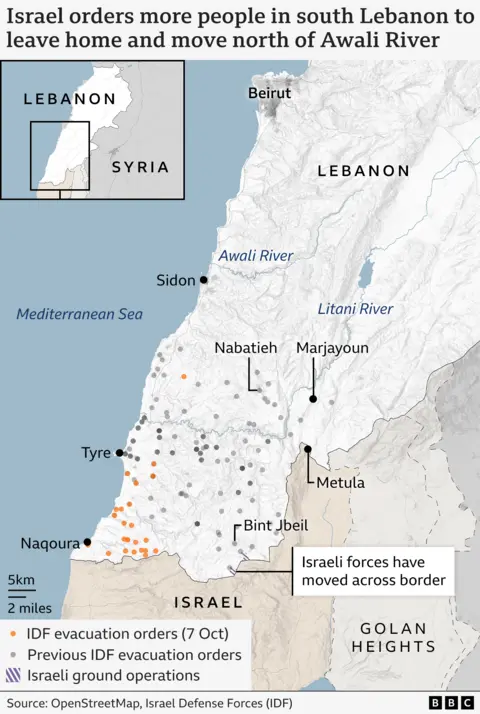
What have Israel’s air strikes targeted?
Israel’s invasion of southern Lebanon came after nearly two weeks of intense air strikes that Israel’s military says target Hezbollah in the south of the country, the eastern Bekaa Valley and the southern suburbs of Beirut.
Israel says it is hitting Hezbollah sites, including weapons stores and ammunition dumps, but Lebanese officials say more than 100 women and children have been killed.
The majority of the rockets recently fired by Hezbollah have targeted northern areas of Israel. But some rockets have reached further south and damaged homes near the coastal city of Haifa.
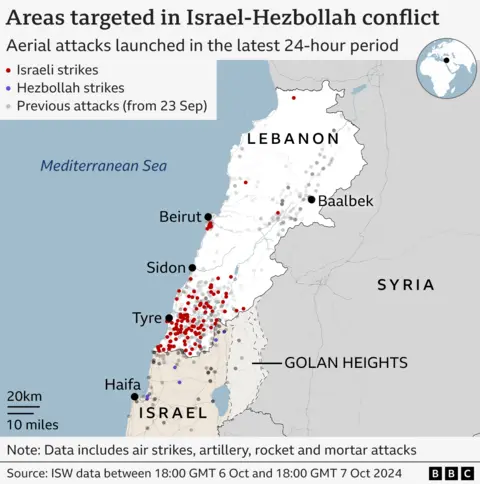
There has been almost a year of cross-border hostilities between Israel’s forces and Hezbollah, sparked by the war in Gaza.
Hezbollah has fired thousands of rockets at northern Israel during that time, forcing some Israelis living there to flee south, while the IDF has launched air strikes and artillery fire against Hezbollah positions in Lebanon.
As the chart below shows, the number of weekly Israeli attacks on Lebanon more than tripled in the week before the IDF launched its ground invasion. The number of Hezbollah attacks, while small in comparison, also increased in the same week.
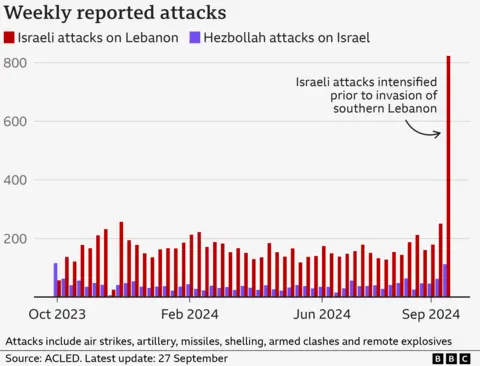
Israel has intensified strikes on Beirut, the capital of Lebanon, in recent days.
The majority of the strikes have hit the southern suburbs of the city, densely populated areas that are home to thousands of civilians.
These areas, close to the international airport, also have a strong Hezbollah presence and a series of Israeli strikes on buildings there killed Hezbollah’s leader Hassan Nasrallah on 27 September.
There have also been Israeli aerial attacks on locations closer to the centre of the city. A strike on an apartment block close to the Lebanese parliament building on 2 October killed several people, including rescue officers and paramedics, according to Beirut’s civil defence.
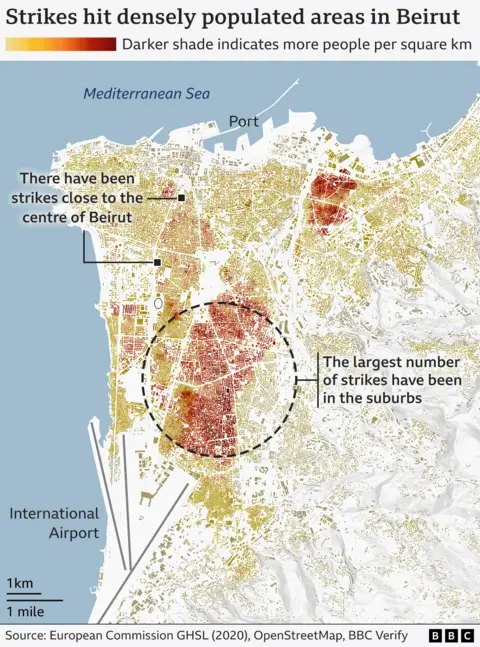
The map below – using analysis of satellite data by Corey Scher of CUNY Graduate Center and Jamon Van Den Hoek of Oregon State University – shows which areas have sustained concentrated damage – including Dahieh in Beirut and areas along the border with Israel.
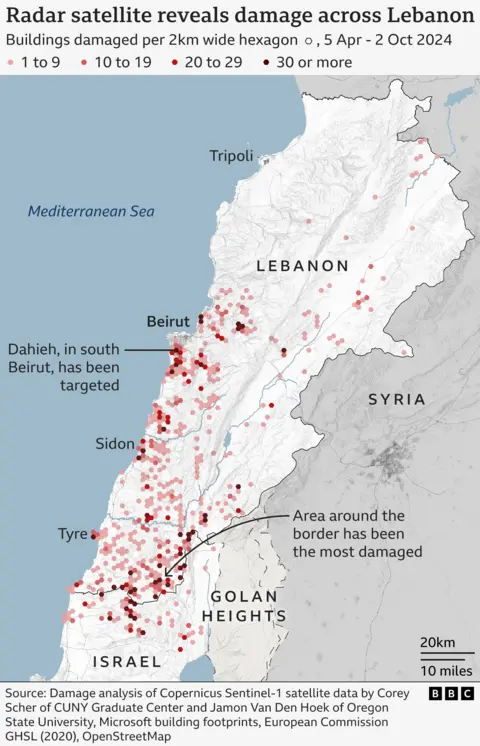
What will Israel do next?
Israel is now engaged in hostilities with armed forces and non-state armed groups in several countries in the Middle East, including Iran, Syria and Iran-backed groups operating in Lebanon, Gaza, Iraq, Syria and Yemen.
Iran’s ballistic missile attack against Israel on Tuesday was the latest major escalation.
What happens next is unclear, but Israel has vowed to respond, with Prime Minister Benjamin Netanyahu describing the attack as “a big mistake” that Iran “will pay for”.
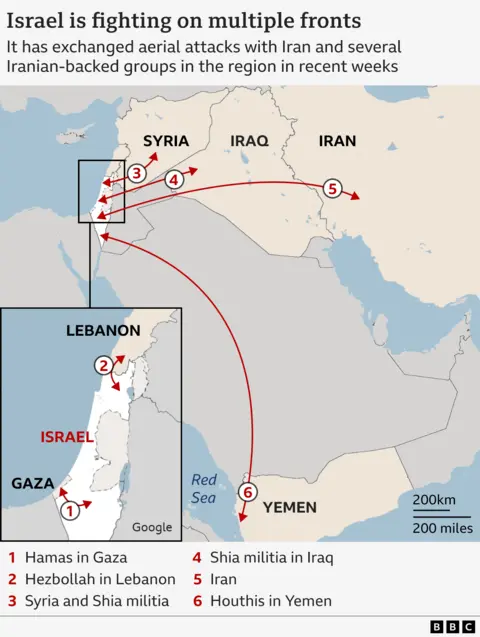
Business
TikTok sued for ‘wreaking havoc’ on teen mental health
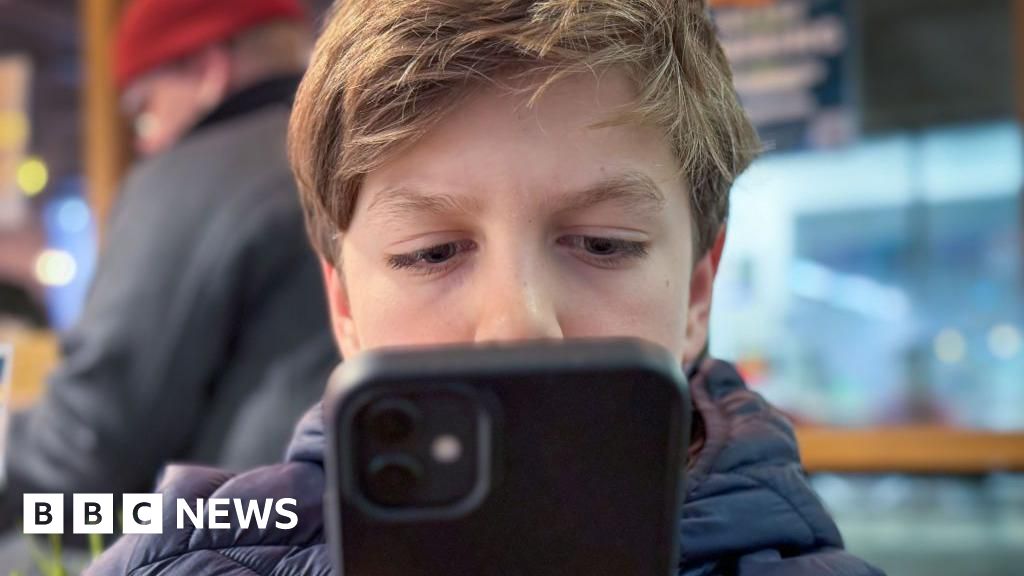
 Getty Images
Getty ImagesMore than a dozen states in the US have sued TikTok, accusing the social media platform of helping to drive a mental health crisis among teenagers.
A bipartisan group of 14 attorneys general from across the country allege that the company uses addictive features to hook children to the app and that it has intentionally misled the public about the safety of prolonged use.
TikTok did not immediately respond to a request for comment. It adds to the legal woes facing the wildly popular app, which more than half of US teenagers are estimated to use multiple times a day.
TikTok is already battling a law passed by Congress in April that would ban it from the US, unless Chinese parent company Bytedance agreed to a sale.
“TikTok knows that compulsive use of and other harmful effects of its platform are wreaking havoc on the mental health of millions of American children and teenagers,” said the lawsuit filed in New York on Tuesday.
“Despite such documented knowledge, TikTok continually misrepresents its platform as ‘safe’ [and] ‘appropriate for children and teenagers’.”
New York Attorney General Letitia James said young people across the country had died or been injured doing TikTok “challenges” and many others were feeling “more sad, anxious and depressed because of TikTok’s addictive features”.
She cited a 15-year-old boy, who died in Manhattan while “subway surfing” – riding on top of a moving subway car. His mother later found TikTok videos of such activity on his phone, she said.
“TikTok claims that their platform is safe for young people, but that is far from true,” Ms James said in a statement announcing the action.
The lawsuit singles out certain features as problematic: alerts that disrupt sleep; videos that vanish, driving users to check the platform frequently; and beauty filters that allow users to augment their appearance.
Though TikTok has promoted tools aimed at helping people limit their screen-time or resetting what content they are served, it has misrepresented their effectiveness, according to the lawsuit.
The lawsuits were filed by 13 states separately and in the District of Columbia, where the attorney general also accused the company of running an unlicensed money transmission business via its “virtual currency” offering.
The lawsuit asks the court to bar TikTok from such conduct and seeks financial penalties.
Regulators have launched similar cases against Facebook and Instagram for their impact on young people’s mental health.
States such as Texas and Utah have also previously filed similar suits against TikTok focused on child safety.
The Federal Trade Commission, a national watchdog, also accused TikTok of violating child privacy laws in August.
Money
FOS and FCA should work together on simplified advice


Simplified advice can only be achieved if the Financial Ombudsman Service (FOS) and the Financial Conduct Authority (FCA) work together, according to an industry expert.
Ian McKenna, founder of Financial Technology Research Centre, made the statement today (8 October) at Money Marketing Interactive in London.
The FCA announced proposals to launch a simplified advice model last December to make it easier for firms to provide affordable personal recommendations to those with simpler needs and smaller sums to invest.
McKenna, who was part of a panel discussing the future of advice, said for simplified advice to work, the Ombudsman needs to be part of the process.
However, he queried whether the regulator would be willing to make that decision.
He said: “The reality for simplified advice is the regulator would never bring the Ombudsman along. The argument was always do less, charge more or charge less, but still have the same responsibility at the end.
“This why I’m saying, and you could argue with my response, we don’t need the movement of the [advice/guidance] boundary.”
McKenna added that attempts were made in the past to address the issue of advice gap without much success.
“There’s no example of that happening in the past 20-30 years. Why would it be different now? What worries me is a huge amount of effort will be expended on something that just isn’t economically viable,” he said.
McKenna said the sector needs to tread with caution on the advice/guidance boundary review to avoid the equivalent of PPI in the long-term savings market.
“I think if we just remove the boundary, that’s what we will end up with and that will be devastating to people for long-term confidence.”
Tom Selby, director of policy at AJ Bell, said the advice/guidance boundary review is a test for the Consumer Duty and an opportunity for the regulator to assess how the financial services sector is abiding by the core terms of it.
He said the regulator now has access to huge amounts of data on firms to hold them accountable on their Consumer Duty commitments.
“It’s on them to make sure that firms do ultimately understand their shareholders.
“When they look at the cost benefit analysis of ‘am I going to throw people into an inappropriate product or am I going to follow the Consumer Duty?’
“Besides, if I don’t follow the Consumer Duty, I’m going to end up with a huge fine and a bad reputation.”
News
Mum & lover ‘wheeled toddler’s body around in buggy for THREE days after she died from regime of escalating brutality’
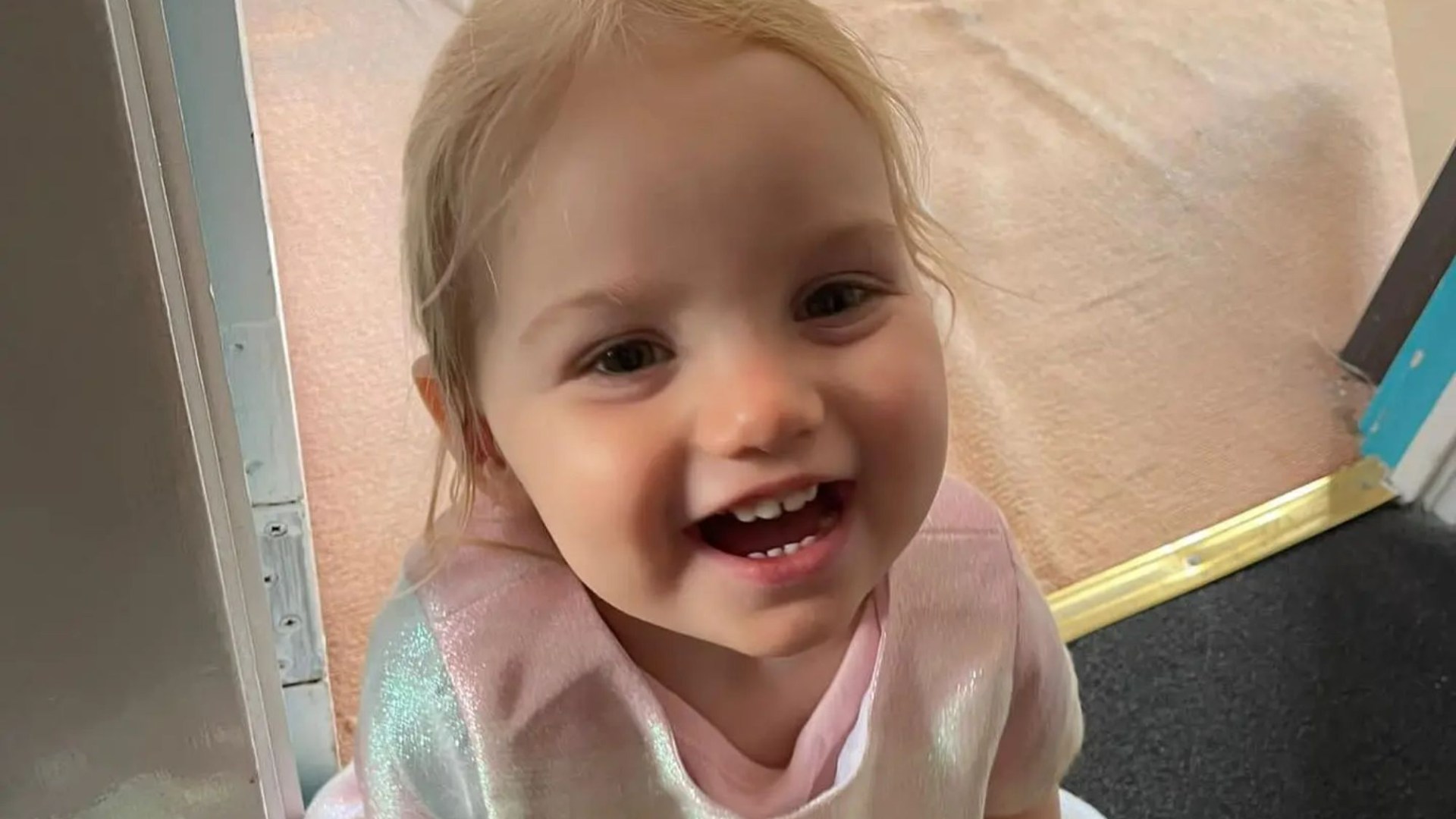
A MUM and her lover wheeled a toddler’s body around for three days in her buggy after she died from a “regime of escalating brutality”, a court heard.
Isabella Rose Wheildon suffered horror injuries after she was allegedly kicked or stomped on by 24-year-old Scott Jeff.
Jurors heard how the two-year-old is believed to have died on June 26 last year in a temporary housing unit in Ipswich.
But Jeff and Isabella’s mum Chelsea Gleason-Mitchell, also 24, allegedly kept the girl’s death a secret.
Ipswich Crown Court was told they carried on pushing her body around in a pushchair with the hood pulled up to shield her face.
The couple also allegedly took her corpse on a shopping trip to buy computer gaming equipment.
She was finally discovered on June 30 under blankets in a shower at the housing unit.
The court was told police officers had been greeted by a “very strong smell” when the bathroom was unlocked.
One pulled back the blankets to see the “face of a young child who was not moving”.
Prosecutor Sally Howes KC said: “He was aware of severe bruising on her face. She was cold to the touch.”
The discovery was made when a woman reported to police on June 30 that she had received a Facebook message from a “friend of hers”.
Ms Howes said: “That message disclosed that her friend’s daughter had died in her sleep three days before and was in her pushchair in the bathroom.
“That friend was the first defendant, Chelsea Gleason-Mitchell, and her daughter was Isabella.”
Gleason-Mitchell is accused of allowed her daughter’s death to happen as she “stood back, watched and did nothing”.
A post mortem found she had “extensive external traumatic injuries to the soft tissues of the body including head, neck, torso, limbs” and other areas.
She had also suffered fractures to both wrists and a “complex pelvic fracture involving several bones”.
Her cause of death was given as “bone marrow embolism caused by skeletal trauma”.
‘Regime of escalating brutality’
The court heard this “severe” damage to her pelvis was likely caused by “either kicking or stamping or both”.
Ms Howes said: “It’s the prosecution case that Isabella Wheildon was a healthy, contented, well-cared for little girl until Scott Jeff came into her young life.
“Towards the end of May 2023, he entered a relationship with Chelsea Gleason-Mitchell.
“From that time up to her death, Isabella was subjected to a regime of escalating brutality which was callous, cruel and ultimately fatal.”
Gleason-Mitchell and Jeff lived together in hotels in Great Yarmouth, a caravan park and “camping in a very small tent on Caister beach” in Norfolk before they ended up in Ipswich.
The mum told Great Yarmouth Borough Council she and her daughter were “homeless” and escaping domestic abuse from her ex.
She also falsely claimed Jeff was Isabella’s biological dad and refused a home by Bedfordshire Council for her and the youngster as she wanted to stay with her partner.
After moving into the unit, CCTV showed the toddler being pushed around in her chair, wearing sunglasses with the hood up, concealing her head, it was said.
The court heard the couple went with Isabella out on June 26, visiting a barber shop so Jeff could get a haircut.
They returned at 3.15pm with CCTV showing the youngster’s legs and feet moving in her pushchair – suggesting she was still alive.
The court was told this is believed to the last image of Isabella and that she had died later that day.
Jeff has denied causing or allowing Isabella’s death and murder.
Gleason-Mitchell has pleaded guilty to causing or allowing the death of a child but denies murder.
The trial continues.
-

 Womens Workouts2 weeks ago
Womens Workouts2 weeks ago3 Day Full Body Women’s Dumbbell Only Workout
-

 Science & Environment3 weeks ago
Science & Environment3 weeks agoHow to unsnarl a tangle of threads, according to physics
-

 Science & Environment3 weeks ago
Science & Environment3 weeks agoHyperelastic gel is one of the stretchiest materials known to science
-

 Technology3 weeks ago
Technology3 weeks agoWould-be reality TV contestants ‘not looking real’
-

 Science & Environment3 weeks ago
Science & Environment3 weeks ago‘Running of the bulls’ festival crowds move like charged particles
-

 Science & Environment3 weeks ago
Science & Environment3 weeks agoMaxwell’s demon charges quantum batteries inside of a quantum computer
-

 News2 weeks ago
News2 weeks agoOur millionaire neighbour blocks us from using public footpath & screams at us in street.. it’s like living in a WARZONE – WordupNews
-
News3 weeks ago
the pick of new debut fiction
-

 Science & Environment3 weeks ago
Science & Environment3 weeks agoHow to wrap your mind around the real multiverse
-

 Science & Environment3 weeks ago
Science & Environment3 weeks agoQuantum ‘supersolid’ matter stirred using magnets
-

 Science & Environment3 weeks ago
Science & Environment3 weeks agoSunlight-trapping device can generate temperatures over 1000°C
-

 Science & Environment3 weeks ago
Science & Environment3 weeks agoLiquid crystals could improve quantum communication devices
-

 Science & Environment3 weeks ago
Science & Environment3 weeks agoITER: Is the world’s biggest fusion experiment dead after new delay to 2035?
-

 Science & Environment3 weeks ago
Science & Environment3 weeks agoQuantum forces used to automatically assemble tiny device
-

 Science & Environment3 weeks ago
Science & Environment3 weeks agoPhysicists are grappling with their own reproducibility crisis
-

 Science & Environment3 weeks ago
Science & Environment3 weeks agoWhy this is a golden age for life to thrive across the universe
-

 News3 weeks ago
News3 weeks agoYou’re a Hypocrite, And So Am I
-

 Sport3 weeks ago
Sport3 weeks agoJoshua vs Dubois: Chris Eubank Jr says ‘AJ’ could beat Tyson Fury and any other heavyweight in the world
-

 Science & Environment3 weeks ago
Science & Environment3 weeks agoTime travel sci-fi novel is a rip-roaringly good thought experiment
-

 Science & Environment3 weeks ago
Science & Environment3 weeks agoLaser helps turn an electron into a coil of mass and charge
-

 Science & Environment3 weeks ago
Science & Environment3 weeks agoCaroline Ellison aims to duck prison sentence for role in FTX collapse
-

 Science & Environment3 weeks ago
Science & Environment3 weeks agoNuclear fusion experiment overcomes two key operating hurdles
-
Business1 week ago
Eurosceptic Andrej Babiš eyes return to power in Czech Republic
-

 Science & Environment3 weeks ago
Science & Environment3 weeks agoNerve fibres in the brain could generate quantum entanglement
-

 Technology1 week ago
Technology1 week ago‘From a toaster to a server’: UK startup promises 5x ‘speed up without changing a line of code’ as it plans to take on Nvidia, AMD in the generative AI battlefield
-

 Football1 week ago
Football1 week agoFootball Focus: Martin Keown on Liverpool’s Alisson Becker
-

 Science & Environment3 weeks ago
Science & Environment3 weeks agoRethinking space and time could let us do away with dark matter
-

 News3 weeks ago
News3 weeks ago▶️ Hamas in the West Bank: Rising Support and Deadly Attacks You Might Not Know About
-

 Science & Environment2 weeks ago
Science & Environment2 weeks agoX-rays reveal half-billion-year-old insect ancestor
-

 MMA1 week ago
MMA1 week agoConor McGregor challenges ‘woeful’ Belal Muhammad, tells Ilia Topuria it’s ‘on sight’
-
Business1 week ago
Should London’s tax exiles head for Spain, Italy . . . or Wales?
-

 News3 weeks ago
News3 weeks ago▶️ Media Bias: How They Spin Attack on Hezbollah and Ignore the Reality
-

 Science & Environment3 weeks ago
Science & Environment3 weeks agoA slight curve helps rocks make the biggest splash
-

 News3 weeks ago
News3 weeks agoNew investigation ordered into ‘doorstep murder’ of Alistair Wilson
-

 News3 weeks ago
News3 weeks agoIsrael strikes Lebanese targets as Hizbollah chief warns of ‘red lines’ crossed
-

 Science & Environment3 weeks ago
Science & Environment3 weeks agoFuture of fusion: How the UK’s JET reactor paved the way for ITER
-

 Science & Environment3 weeks ago
Science & Environment3 weeks agoA new kind of experiment at the Large Hadron Collider could unravel quantum reality
-

 Science & Environment3 weeks ago
Science & Environment3 weeks agoUK spurns European invitation to join ITER nuclear fusion project
-

 CryptoCurrency3 weeks ago
CryptoCurrency3 weeks agoCardano founder to meet Argentina president Javier Milei
-

 News2 weeks ago
News2 weeks agoWhy Is Everyone Excited About These Smart Insoles?
-

 Science & Environment2 weeks ago
Science & Environment2 weeks agoMeet the world's first female male model | 7.30
-

 Technology2 weeks ago
Technology2 weeks agoGet ready for Meta Connect
-

 Health & fitness1 week ago
Health & fitness1 week agoThe 7 lifestyle habits you can stop now for a slimmer face by next week
-

 Science & Environment3 weeks ago
Science & Environment3 weeks agoWhy we need to invoke philosophy to judge bizarre concepts in science
-

 CryptoCurrency3 weeks ago
CryptoCurrency3 weeks agoLow users, sex predators kill Korean metaverses, 3AC sues Terra: Asia Express
-

 Womens Workouts2 weeks ago
Womens Workouts2 weeks agoBest Exercises if You Want to Build a Great Physique
-

 Womens Workouts2 weeks ago
Womens Workouts2 weeks agoEverything a Beginner Needs to Know About Squatting
-

 News2 weeks ago
News2 weeks agoFour dead & 18 injured in horror mass shooting with victims ‘caught in crossfire’ as cops hunt multiple gunmen
-

 Technology2 weeks ago
Technology2 weeks agoRobo-tuna reveals how foldable fins help the speedy fish manoeuvre
-

 Technology1 week ago
Technology1 week agoQuantum computers may work better when they ignore causality
-

 Sport1 week ago
Sport1 week agoWatch UFC star deliver ‘one of the most brutal knockouts ever’ that left opponent laid spark out on the canvas
-

 CryptoCurrency3 weeks ago
CryptoCurrency3 weeks agoEthereum is a 'contrarian bet' into 2025, says Bitwise exec
-

 Health & fitness3 weeks ago
Health & fitness3 weeks agoThe secret to a six pack – and how to keep your washboard abs in 2022
-
Business3 weeks ago
JPMorgan in talks to take over Apple credit card from Goldman Sachs
-

 Science & Environment3 weeks ago
Science & Environment3 weeks agoQuantum time travel: The experiment to ‘send a particle into the past’
-

 Science & Environment3 weeks ago
Science & Environment3 weeks agoBeing in two places at once could make a quantum battery charge faster
-

 Science & Environment3 weeks ago
Science & Environment3 weeks agoA tale of two mysteries: ghostly neutrinos and the proton decay puzzle
-

 CryptoCurrency3 weeks ago
CryptoCurrency3 weeks agoBitcoin miners steamrolled after electricity thefts, exchange ‘closure’ scam: Asia Express
-

 CryptoCurrency3 weeks ago
CryptoCurrency3 weeks agoDorsey’s ‘marketplace of algorithms’ could fix social media… so why hasn’t it?
-

 CryptoCurrency3 weeks ago
CryptoCurrency3 weeks agoDZ Bank partners with Boerse Stuttgart for crypto trading
-

 CryptoCurrency3 weeks ago
CryptoCurrency3 weeks agoBitcoin bulls target $64K BTC price hurdle as US stocks eye new record
-

 CryptoCurrency3 weeks ago
CryptoCurrency3 weeks agoBlockdaemon mulls 2026 IPO: Report
-
News3 weeks ago
The Project Censored Newsletter – May 2024
-
Politics3 weeks ago
UK consumer confidence falls sharply amid fears of ‘painful’ budget | Economics
-

 TV2 weeks ago
TV2 weeks agoCNN TÜRK – 🔴 Canlı Yayın ᴴᴰ – Canlı TV izle
-

 Science & Environment2 weeks ago
Science & Environment2 weeks agoCNN TÜRK – 🔴 Canlı Yayın ᴴᴰ – Canlı TV izle
-

 Womens Workouts2 weeks ago
Womens Workouts2 weeks ago3 Day Full Body Toning Workout for Women
-

 Servers computers2 weeks ago
Servers computers2 weeks agoWhat are the benefits of Blade servers compared to rack servers?
-

 News2 weeks ago
News2 weeks agoUS Newspapers Diluting Democratic Discourse with Political Bias
-

 Technology1 week ago
Technology1 week agoThe best robot vacuum cleaners of 2024
-

 Politics3 weeks ago
Politics3 weeks agoTrump says he will meet with Indian Prime Minister Narendra Modi next week
-

 Sport3 weeks ago
Sport3 weeks agoUFC Edmonton fight card revealed, including Brandon Moreno vs. Amir Albazi headliner
-

 Science & Environment3 weeks ago
Science & Environment3 weeks agoHow one theory ties together everything we know about the universe
-

 News3 weeks ago
News3 weeks agoBrian Tyree Henry on voicing young Megatron, his love for villain roles
-

 Technology3 weeks ago
Technology3 weeks agoThe ‘superfood’ taking over fields in northern India
-

 Science & Environment3 weeks ago
Science & Environment3 weeks agoTiny magnet could help measure gravity on the quantum scale
-

 Science & Environment3 weeks ago
Science & Environment3 weeks agoHow do you recycle a nuclear fusion reactor? We’re about to find out
-

 CryptoCurrency3 weeks ago
CryptoCurrency3 weeks agoDecentraland X account hacked, phishing scam targets MANA airdrop
-

 CryptoCurrency3 weeks ago
CryptoCurrency3 weeks agoRedStone integrates first oracle price feeds on TON blockchain
-

 CryptoCurrency3 weeks ago
CryptoCurrency3 weeks ago‘No matter how bad it gets, there’s a lot going on with NFTs’: 24 Hours of Art, NFT Creator
-
Business3 weeks ago
Thames Water seeks extension on debt terms to avoid renationalisation
-
Business3 weeks ago
How Labour donor’s largesse tarnished government’s squeaky clean image
-
Politics3 weeks ago
‘Appalling’ rows over Sue Gray must stop, senior ministers say | Sue Gray
-

 News3 weeks ago
News3 weeks agoBrian Tyree Henry on voicing young Megatron, his love for villain roles
-

 CryptoCurrency3 weeks ago
CryptoCurrency3 weeks agoCoinbase’s cbBTC surges to third-largest wrapped BTC token in just one week
-

 MMA2 weeks ago
MMA2 weeks agoRankings Show: Is Umar Nurmagomedov a lock to become UFC champion?
-

 Travel2 weeks ago
Travel2 weeks agoDelta signs codeshare agreement with SAS
-

 Politics2 weeks ago
Politics2 weeks agoHope, finally? Keir Starmer’s first conference in power – podcast | News
-
Business1 week ago
Ukraine faces its darkest hour
-

 News3 weeks ago
News3 weeks agoChurch same-sex split affecting bishop appointments
-

 Technology3 weeks ago
Technology3 weeks agoiPhone 15 Pro Max Camera Review: Depth and Reach
-

 Health & fitness3 weeks ago
Health & fitness3 weeks agoThe maps that could hold the secret to curing cancer
-

 CryptoCurrency3 weeks ago
CryptoCurrency3 weeks agoCrypto scammers orchestrate massive hack on X but barely made $8K
-

 CryptoCurrency3 weeks ago
CryptoCurrency3 weeks agoSEC asks court for four months to produce documents for Coinbase
-

 CryptoCurrency3 weeks ago
CryptoCurrency3 weeks ago‘Silly’ to shade Ethereum, the ‘Microsoft of blockchains’ — Bitwise exec
-

 Womens Workouts3 weeks ago
Womens Workouts3 weeks agoHow Heat Affects Your Body During Exercise
-

 Womens Workouts3 weeks ago
Womens Workouts3 weeks agoKeep Your Goals on Track This Season
-

 Science & Environment3 weeks ago
Science & Environment3 weeks agoSingle atoms captured morphing into quantum waves in startling image
-

 News3 weeks ago
News3 weeks agoHow FedEx CEO Raj Subramaniam Is Adapting to a Post-Pandemic Economy
-

 CryptoCurrency3 weeks ago
CryptoCurrency3 weeks agoTelegram bot Banana Gun’s users drained of over $1.9M

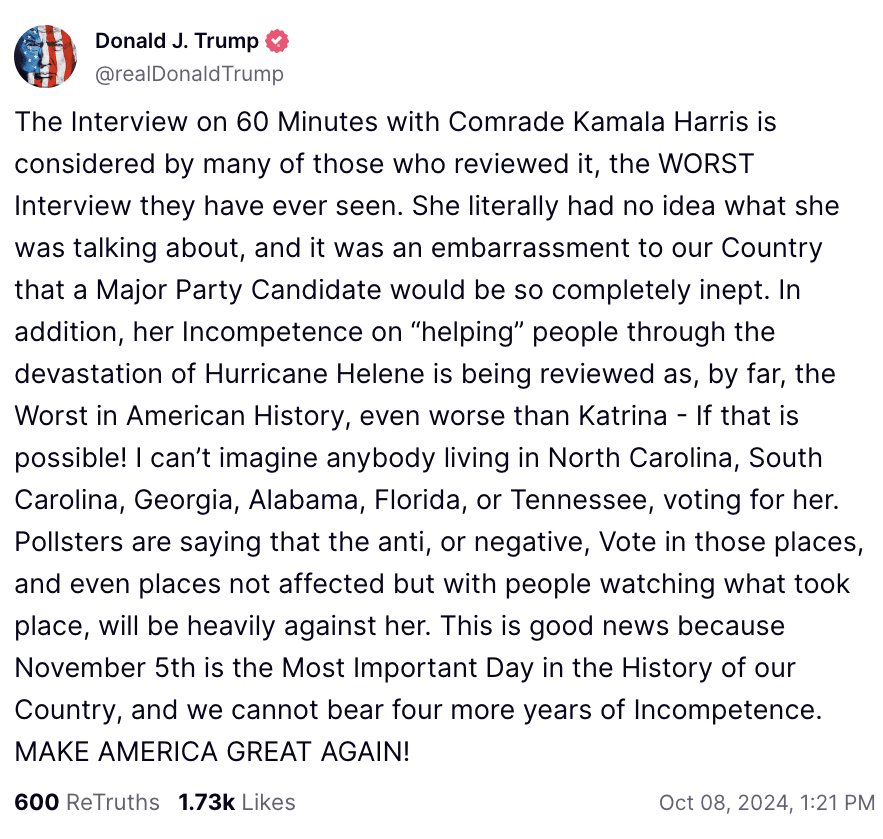


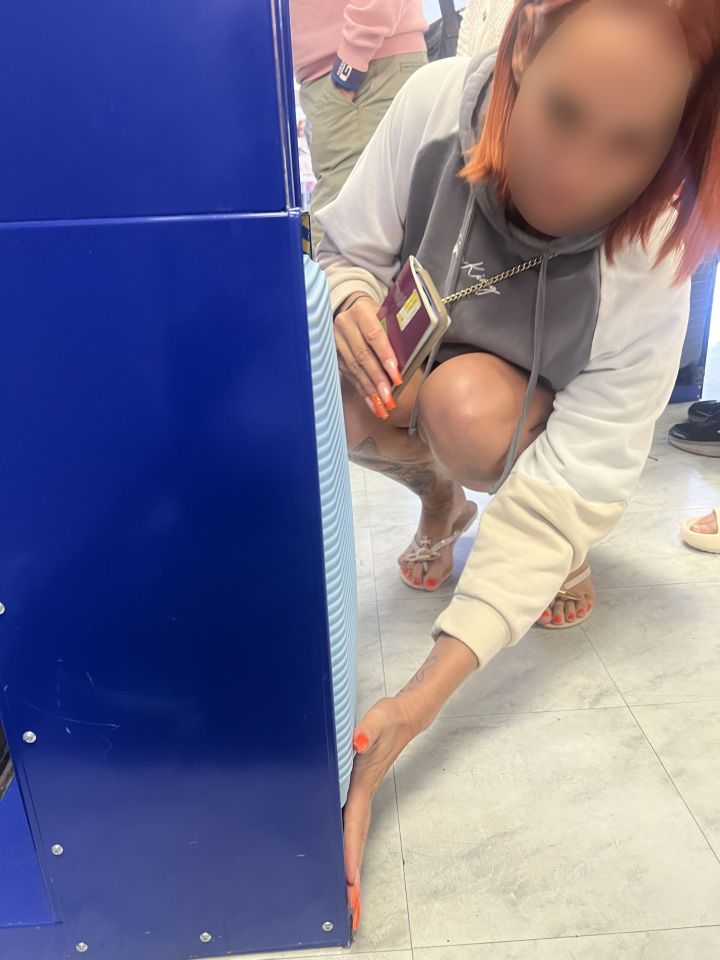





You must be logged in to post a comment Login